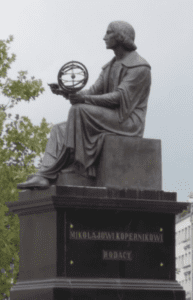Arpan K. Banerjee
Solihull, United Kingdom
 |
| Fig 1. Statue of Copernicus, Warsaw, Poland. Photo by Arpan K. Banerjee. |
Nicolaus Copernicus was born on 19 Feb 1473 in the Prussian town of Torun, now part of Poland. He studied at the Jagiellonian University of Cracow, and although his main subjects were mathematics and astronomy, he also immersed himself in philosophy and read the works of Aristotle, Ptolemy, and Euclid.
In 1495 he left the university without graduating and become a canon in the cathedral at Warmia in Frauenburg. He was a devout Catholic and never married, nor did he have children. From 1496 to 1500 he studied canon law at Bologna, learned Greek and Latin, and became fluent in Italian. He read Pliny, Plutarch, and Cicero and pursued an interest in astronomy.
In 1501 he studied medicine at Padua. He studied anatomy under della Torre, a friend of Leonardo da Vinci, and also under Girolamo Fracastorius, today considered the father of infectious diseases and author of the famous 1530 poem Syphilis sive morbus Gallicus (“Syphilis or the French Disease”). He also studied with Trapolini the mathematician and still pursued his interests in the antiquities as well as in astronomy, then considered a part of medical education.
Copernicus returned to Warmia, Poland, with a doctorate in canon law and medical knowledge that enabled him to practice as a physician. He treated the rich and the poor. He was physician to King Sigismund of Poland, whose statue now stands in the square in front of the Royal Castle in Warsaw. He was interested in public health and helped control the plague epidemic in Poland at that time. He was an early advocate of clean drinking water and sanitation. Although he performed medical, ecclesiastical, and administrative duties, he still had time to pursue his interests in Greek and astronomy.
Today Copernicus is remembered not for his contributions to medicine, but for his study of the solar system. In 1514 he recognized that the Earth orbits around the Sun, but he did not publish his ideas in monograph form for some time. His famous book On the Revolutions of the Celestial Spheres was published in 1543, the year of his death. Copernicus’ ground-breaking work, although at first met with hostility by religious groups, changed forever our understanding of the universe. Today he is considered one of the greatest scientists and polymaths of all time.
Copernicus was not only a physician but also a mathematician, astronomer, lawyer, theologian, diplomat, linguist, classicist, philosopher, and important early contributor to theories of economics. His heliocentric model of the universe started a scientific revolution. The year of his death saw another remarkable intellectual giant, Andreas Vesalius, publish his famous anatomical work De Humanis Corporis Fabrica, which revolutionized medicine.
Today the university in Torun, Poland, is named after him. It is also fitting that a statue honoring him (Fig. 1) stands in front of the Polish Academy of Sciences in Warsaw. The bronze statue was designed by the Danish sculptor Bertel Thorvaldsen in 1822 and was completed in 1830.
References
- “Nicolaus Copernicus.” Wikipedia. https://en.wikipedia.org/wiki/Nicolaus_Copernicus.
- Moran, M. (2014). Doctors of Another Calling, p. 21-33.
- Warsaw, What a History. [email protected].
- Banerjee, A. K. “Medical Statues – Hieronymous Fracastorius.” Alma Culture and Medicine, May 2015, p 44-45.
DR. ARPAN K. BANERJEE qualified in medicine at St Thomas’s Hospital Medical School, London. He was a consultant radiologist in Birmingham 1995–2019. He was President of the radiology section of the RSM 2005-2007 and on the scientific committee of the Royal College of Radiologists 2012–2016. He was Chairman of the British Society for the History of Radiology 2012–2017. He is Chairman of ISHRAD. He is author/co-author of papers on a variety of clinical, radiological, and medical historical topics and seven books, including Classic Papers in Modern Diagnostic Radiology (2005) and The History of Radiology (OUP 2013).
Winter 2022 | Sections | Physicians of Note

Leave a Reply